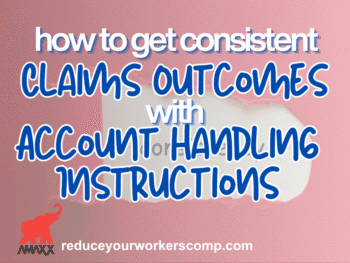Complete job descriptions, with proper compliance can help reduce workers compensation loss values.
They can be used both as preventative measure and as a tool to reduce a claim exposure. Job descriptions that are stated clearly, as well as describe all duties and functions, will bring the most desired results.
Preventative Uses:
- Job descriptions can be used for pre-employment physical examinations, which can eliminate the physically unqualified who might have an on the job injury.
- Employment interviewers, using the job description, will be able to screen potential employees.
- To recognize persons who might violate the job provisions.
- They should be able to determine persons who can misunderstand functions.
- Through personnel tests geared to job duties interviewers might be able to discern people with attitude issues.
- Testing may uncover problems for ability to train, or fail to meet provisions in the job description.
Click Link to Access Free PDF Download
Uses after a loss are presented:
- Job descriptions, along with possible video showing the job operation, should be furnished to attending or consulting medical providers, which allows for a proper determination about the employee’s ability to perform the job within the physical capacities.
- To determine if the employee can return to duty sooner than expected.
- Investigating a claim with a job description might prove that the injury could or could not have occurred as reported.
- To uncover safety and procedural operational failures that could be remedied. The same failures could serve disciplinary needs.
- A job description investigation can also lead to changes or modifications of the job description itself.
Developing the Job Description:
Good job descriptions are detailed, practical, and accurate. They should:
- Be done in writing, using language that meets the employee’s standard of understanding.
- Detail step by step every task to perform. Be as specific as possible. Use visual aids whenever possible.
- Outline purpose and responsibilities.
- Cover any relationships to other jobs.
- Detail educational and physical requirements.
- State all experience and training needs. Cover how each process relates.
- Cover the job title and any alternative names
- Detail safety steps and equipment needed.
- Cover any licensing, continued training, or other legal requirements.
- Define scope and course for performance.
- Set provisions for off premises operations where necessary.
- Cover established time frames for doing the job.
- Define all equipment needs and how to use it.
- Disciplinary measures for failure to follow the job description.
- Steps to follow when employee performance cannot comply with the description.
- Define any potential future employee job growth or developments that might come from this job.
- Be flexible and monitored for necessary changes.
- Cover managerial and supervisory authorities.
- Outline how the job description interfaces with employee hand books, union contracts, and jurisdictional law.
- Steps to take in the event of functional or operational failures.
- Cover wage and other compensation provisions that deviate from the employee handbook.
Gain Other Input:
It is suggested that industrial engineering people help develop or assist in writing the descriptions as they can observe the job while being performed. They will tend to be more objective in their analysis and have experience conducive to your industry. Finally, they may have alternate ideas for performance.
Enlist the employee’s ideas and/or observe how they perform each operation.
Obtaining a legal review is a benefit if the job entails corporate programs that are or should be privileged. When the job falls under union contract or arrangement, getting the union approval or signoff is also recommended.
FREE DOWNLOAD: “Step-By-Step Process To Master Workers’ Comp In 90 Days”
Supplements for Job Descriptions:
Maintaining good corporate policy, education, along with sound attitude and culture should help build employee confidence, trust, and compliance. Employees that are treated fairly with genuine concern are more likely to have favorable job performance.
Managers and supervisors need to continually guide the employees in these paths.
Conclusion:
Good job descriptions are useful for pre-employment and post injury issues that can help reduce worker compensation exposure. They must accurately reflect job duties, as well as cover experience, physical and mental requirements. Job descriptions need constant implementation, compliance, and review.
Author Michael Stack, Principal, COMPClub, Amaxx LLC. He is co-author of Your Ultimate Guide To Mastering Workers Comp Costs, and founder of COMPClub an interactive training program teaching workers’ comp cost containment best practices. Through this platform he is in the trenches on a monthly basis with risk managers, brokers, consultants, attorney’s, and adjusters teaching timeless workers’ comp cost containment strategies, as well as working with members to develop new tactics and systems to address the issues facing organizations today. This unique position allows him to continuously be at the forefront of innovation and thought leadership in workers’ compensation cost containment. Contact: mstack@reduceyourworkerscomp.com.
©2015 Amaxx LLC. All rights reserved under International Copyright Law.
Do not use this information without independent verification. All state laws vary. You should consult with your insurance broker, attorney, or qualified professional.
FREE DOWNLOAD: “Step-By-Step Process To Master Workers’ Comp In 90 Days”












